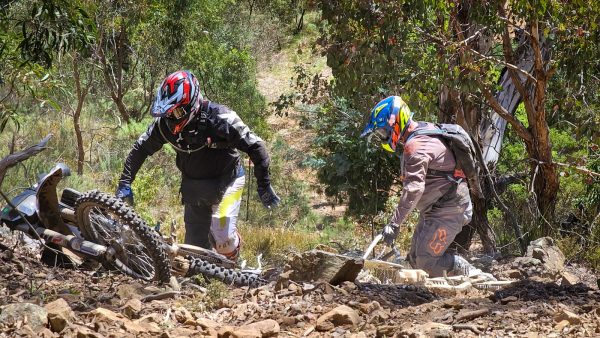Most people wouldn't know what it takes to pull an organised trailride together. We caught up with the track markers too see what happens at the Kowen Forest Ride behind the scenes.
ADB’s Digital Editor Bernie den Hertog and Shaun Lonergan were instrumental in setting up the tracks at the 2023 Kowen Forest Ride. Here’s how Bernie said it all went down at the Kowen Forest Ride behind the scenes.

What does it take to setup an event like this?
I can’t take all the credit – like all big events, there are many volunteers involved and tasks to be undertaken. In my case, we were handling the “hard” loop. I had the overall plan and put the bulk of the work in, while I had some help from a few mates linking the sections together.
How many hours went in to track marking?
We spend many days over eight weeks leading up to the event to put the planned loop together. The actual marking of trails was done on the two days prior to the event. At Kowen we have a lot of people removing trail marking, so it’s not helpful having tracks marked too early.
How many people set up the tracks?
With both loops we had this year we had a team of around 12 volunteers all up. Most weekends we would have a handful come along to assist. Previous years we would have had more than double that.
What do you look for when carving out a track?
We have been holding motorcycle events for decades here, hence many of the trails are already there, albeit covered in pine needles or lost to logging, blackberries or changing government policies. Much of the trail network at Kowen is in place, it’s more a case of attempting to discover what’s left after the extensive logging, and then finding out a way to tie it all together while still avoiding the logging machinery.
Logistics aside, a “good track” has flow (very important as these days many riders are focussed more on aiming for obstacles vs having sweet flow and berms to carve). We can hammer up hills and down them in quick succession and these valleys are awesome fun to bomb down and back up again.
How do you decide how hard it will be?
Ahh this is always a challenge for any large group of riders. On the one hand we want it easy enough that most people can ride the loop. On the other hand, modern bikes make the obstacles that were nigh impossible 10 years ago, seem easy. Hence we have had to take things up a notch this year and make the hard loop truly a challenge.
In previous years we had an A and B line – if the hill was too hard, simply ride around it. I was not keen on this concept as it ruined the flow for riders that tackled the harder lines, only to find they were eating dust two minutes later as the slow riders went around the easy way. All the feedback I received after the ride was positive with most riders beaming with pride having completed the loop and rating it highly.
What is the main aim of a track when setting it up?
A challenge. Some of the best rides that people ever remember are hard. Treacherous conditions, pouring rain or inclement weather. These are the trips that sit firmly in your memory because they pushed you to your limits in some way.
That’s what we tried to provide with the Hard Loop, a good fun loop that was also a challenge to complete while still having enough fast flowy single that you could blow off the steam and chase down your mates. So an ideal loop would be challenging, fun and fast with plenty of tricky technical sections thrown in for good measure. Around 30-40km long see’s most riders satisfied.
What were your favourite parts of the tracks?
Some of the really old flowing tracks we found were the highlight. Tracks that were last ridden 30 years ago. They weaved through the pines with berms at every corner, remnants of old Pony Express’s we rode back in the 80s. The harder rocky sections through the creeks also provide plenty of entertainment.
What would you do differently next time with track marking?
It’s hard to ignore that many hands makes for light work. No question we were light on with volunteers for this event. I personally was madly pre-riding and marking trails for 11hrs and 17hrs straight on the two days leading up to it.
While I doubt we’ll see a return of the massive 1000+ riders at Kowen each year (the club simply does not have the manpower anymore), it does sound like we’ll keep trying to have an annual Kowen ride with 200-300 riders capped – so keep an eye out for next year to get amongst the pines.
BY THE NUMBERS
The DSMRA has had to pare back the legendary Kowen Forest Ride since they restarted it last year. Without the volunteers and funding they had back before COVID-19 it’s simply not possible to run the ride at the same size. If you’d like to help see the Kowen Forest Ride return to the magnitude it once was, put your hand up to help out next time around.
- 205 entrants
- 25 volunteers
- 3 separate loops
- 35km per loop and 15km for the night loop
- 180 hoodies and 110 beanies sold
- 640 raffle tickets sold

